The design of the ignition distributor with a contact breaker
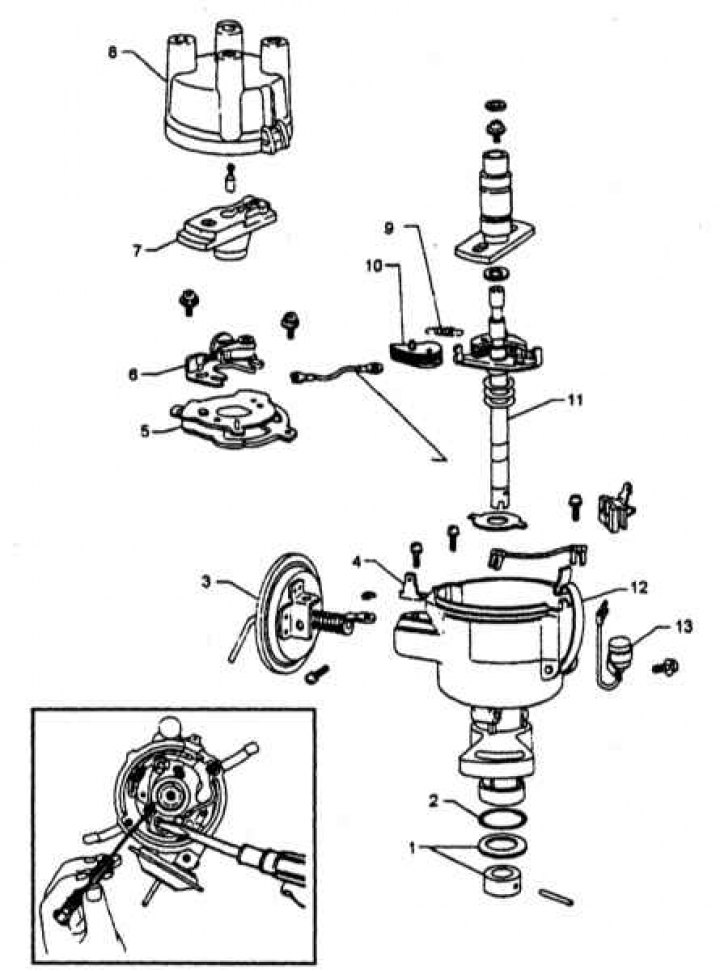
1 - Retainer; 2 - sealing ring; 3 - Diaphragm of the vacuum corrector; 4 - Grounding; 5 - Breaker plate; 6 - Mobile contact holder; 7 - Slider; 8 - Cover; 9 - Spring of the centrifugal regulator; 10 - Weights of the centrifugal regulator; 11 - Shaft; 12 - Housing; 13 - Capacitor
The design of the distributor of the transistor ignition system
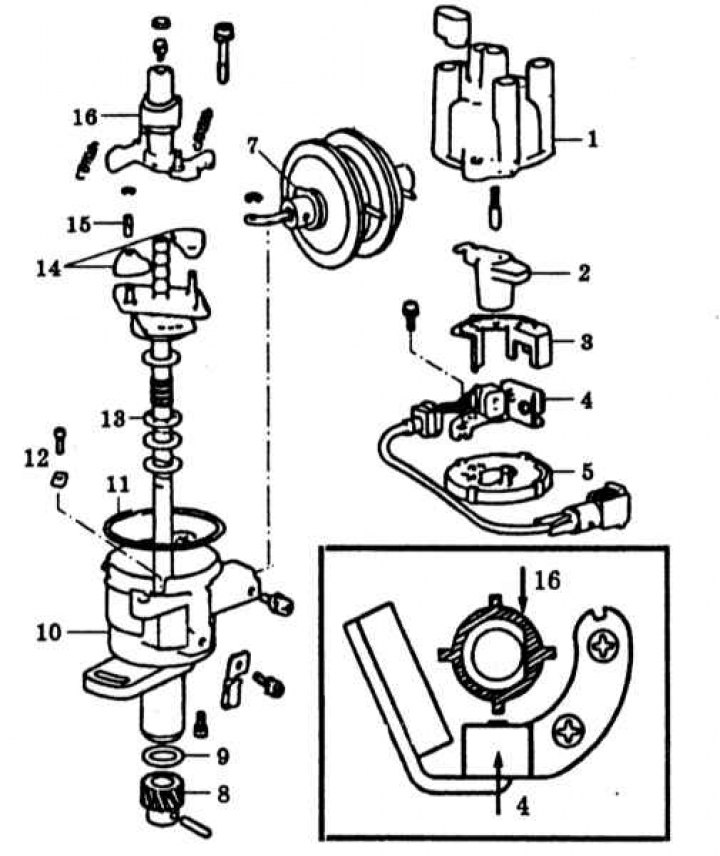
1 - Cover; 2 - Slider; 3 - Dust screen; 4 - Signal generator; 5 - Breaker plate; 6 - Diaphragm of the vacuum corrector; 7 - Gasket; 8 - Drive gear; 9 - O-ring; 10 - Housing; 11 - O-ring; 12 - Thrust bearing; 13 - Regulator shaft; 14 - Weights; 15 - Bearing; 16 - Signal rotor
Check and adjustment
Contact Breaker Distributor
1. The design of the distributor with a contact breaker is shown in the accompanying illustration.
2. Before adjustment, it is necessary to check the condition of the contacts. In case of slight burning, the contacts should be cleaned with fine-grained sandpaper, in case of noticeable defects, they should be replaced.
3. Stripping of contacts is carried out using a diamond file of small thickness. Try to achieve absolute parallelism of the mating surfaces. The bulge of one contact should be eliminated completely, without choosing a recess on the other. After stripping, wipe the contacts with a rag soaked in gasoline.
4. The main causes of severe burning of the contacts include a faulty capacitor, loosening of the fixed contact, or grounding of the breaker. Be sure to check the quality of the ground contacts to the engine ground.
5. Turn a cranked shaft so that there was a full alignment of contacts and measure size of a backlash between them. Compare the measurement result with the requirements of the Specifications, if necessary, loosen the fixing screw and, by shifting the contact with a screwdriver, achieve the required value.
6. Tighten the screw and retest.
7 Now you need to check the duration of the closed state of the contacts (angle of rotation of the crankshaft). Prepare a special meter between the negative terminal of the ignition coil and ground. Start the engine and warm it up to normal operating temperature. Adjust idle speed.
8. Disconnect the vacuum hose from the assembly of the vacuum regulator and measure the angle of stay of the breaker contacts in the closed state. The required value is 52° (angle of rotation of the crankshaft). If necessary, make the appropriate adjustment by adjusting the gap between the contacts.
9. To reduce the angle, increase the gap, to increase - reduce. For different models, the required value of the angle of the closed state of the breaker contacts can be different from the range of 49°÷ 55°.
10. A capacitor is connected in parallel with the contact breaker, which, together with the primary winding of the ignition coil, forms an oscillatory circuit. At the moment of opening the circuit, the capacitor is charged by the self-induction current of the primary winding, which contributes to an increase in the rate of decrease in the magnetic flux, i.e. increase the voltage in the secondary winding. The absorption of the self-induction current at the moment of breaking the circuit reduces the sparking between the contacts of the breaker, as a result of which the reliability of the system is greatly increased.
11. Capacitor breakdowns lead to a breakdown in ignition and a violation of the LV circuit. Signs of a capacitor failure are interruptions in the operation of the engine and significant burning of the breaker contacts.
12. To check the capacitor, you should measure its capacitance, but you can also use a conventional tester by switching it to the high-resistance measurement mode. If the arrow of the device deviates sharply, and then smoothly returns to its original position, therefore, the capacitor is functioning properly. A zero or constantly decreasing reading indicates the need to replace the capacitor
13. There is another simple way to check the condition of the capacitor: with the ignition on, manually open the breaker contacts - if this produces a spark, then the capacitor is damaged.
14. Do not leave the ignition on for a long time with the engine off. If the breaker contacts are closed when the ignition is turned on (the likelihood of such a situation is quite high), as a result of strong heating by the flowing current, the breaker hammer spring can be released with a loss of its elasticity. At the same time, at high speeds, the spring ceases to provide sharp contact closure with the required frequency. As a result, there are interruptions in the operation of the engine, which is usually accompanied by pops in the exhaust system.
15. The insufficiency of the gap in the contacts of the breaker is manifested in interruptions in the operation of the engine in the deceleration mode. In the same way, the weakening of the fastening of the distributor, the contact connectors of the HV circuit, as well as the contact in the ignition switch, is manifested).
16. Reducing the gap in the contacts by 0.01 mm corresponds to a change (increase) the duration of the closed state of the contacts by 1 degree.
17. An increase in the gap in the contacts of the breaker leads to a violation of the stability of high engine speeds.
Transistor ignition distributor
1. The design of the distributor of the transistorized ignition system is shown in the illustration.
2. As part of the routine maintenance of the distributor, periodically check and adjust the air gap of the signal generator.
3. Remove the distributor cap and slider. Turn the crankshaft so that the signal rotor tooth is aligned with the signal generator protrusion and measure the gap between them using a blade-type feeler gauge. The nominal range is 0.2 ÷ 0.4 mm.
4. To adjust the gap, loosen the two fixing screws and rotate the signal generator to the appropriate side, then tighten the screws.
5. Before installing the slider and cover, also check the condition of the segments of the cover and the center electrode. Replace if necessary.
6. To disassemble the distributor, remove it from the vehicle. Remove the slider and plastic dust shield. Remove the O-ring from the housing rim. Turn out two fixing screws and remove assembly of the signal generator with electroconducting.
7. Turn out the fixing screw, release a clamp and the lever and remove assembly of the vacuum regulator.
8. Turn out two fixing screws and remove a breaker plate.
9. Mark the installation position of the regulator springs and remove them from the assembly.
10. Remove the oil slinger from the top of the rotor, unscrew the mounting screw and remove the signal rotor.
11. Mark the installation position of the spring retaining rings and weights of the centrifugal regulator, remove the components.
12. Clean the components and check their condition. Replace defective parts.
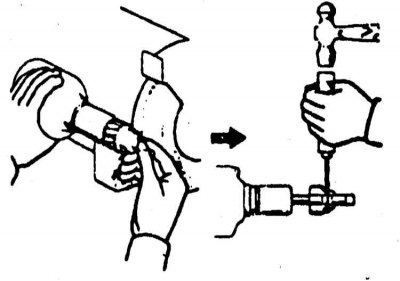
13. With significant wear on the distributor shaft drive gear, saw off or cut off the riveted end of the locking pin, then fix the assembly and knock out the pin.
14. Assembly is carried out in the reverse order. When installing the shaft with gear, match the holes of the bearing holder and the housing, install the shaft and screw in the two mounting screws.
15. Align the pin holes in the gear and shaft. Hammer in a new pin and rivet its ends. Follow the alignment of the marks on the gear and signal rotor.
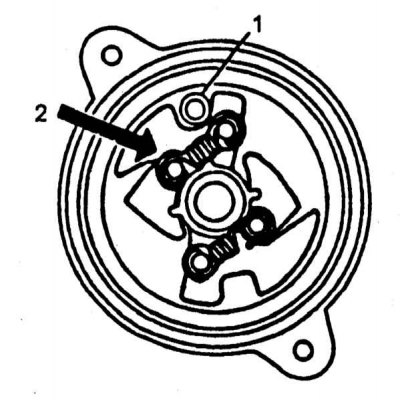
16. Lightly lubricate the governor shaft with clean engine oil, install it on the signal rotor and ensure that the mark is aligned with the locking pin.
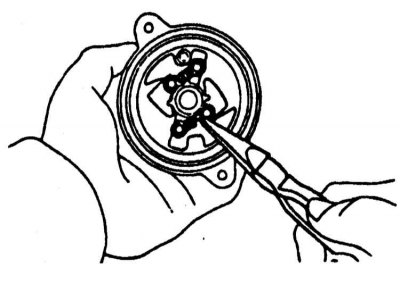
17. Install the weights with bearings, secure the components with circlips.
Note. Weights must be installed strictly in their original places. Reinstall the centrifugal governor springs in their original positions.
18. Screw in and tighten the signal rotor mounting screw. Fill the recess with grease, install the oil deflector (plug). Reinstall the breaker plate. Install the vacuum interrupter assembly.
19. Install the signal generator, screw in, but do not fully tighten, the mounting screws. Align the tooth of the signal rotor with the protrusion of the generator, adjust the gap, then finally tighten the screws.
20. Install dust screen, o-ring, and distributor slider. Install the distributor on the engine.
Note. The sealing ring should fall into the receiving recess on the end face of the distributor.
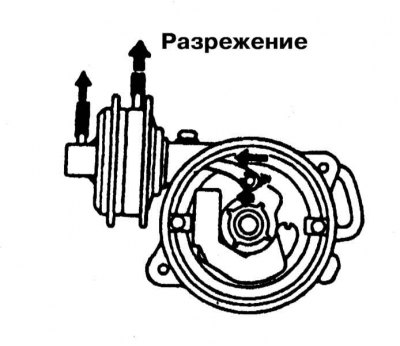
21. Check the correct functioning of the vacuum corrector, for which create a vacuum at the inlet of its diaphragm using a manual vacuum pump - the regulator lever should move when the vacuum depth changes.
Removing
1. Disconnect the negative cable from the battery.
Attention! If the stereo system installed in the car is equipped with a security code, before disconnecting the battery, make sure that you have the correct combination to activate the audio system!
2. If equipped, remove the protective screen from the distributor cap. Please note that the terminal for connecting the spark plug wire of the first cylinder on the distributor cap is marked with a protruding digital mark in the form of 1.
Note. On some distributors, such a label may not be provided.
3. Disconnect the main electrical connector and ground connector from the distributor.
4. Remove the distributor cap (see chapter Settings and ongoing maintenance). Turn the engine by the crankshaft pulley bolt so that the distributor slider turns towards the position of the spark plug wire terminal of the first cylinder on the cover (see Section Bringing the piston of the first cylinder to the top dead center position (TDC)).
5. Mark the position of the slider nose on the rim of the distributor housing. Also mark the position of the base of the distributor housing relative to the surface of the cylinder head.
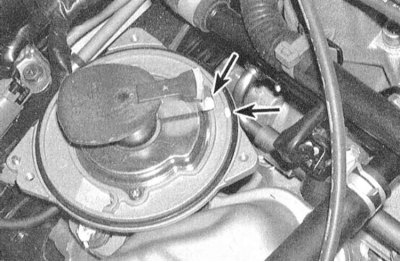 | 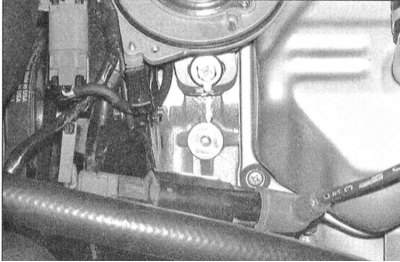 |
6. Turn out a clamping fixing bolt and take assemblage of the distributor from a head of cylinders.
Attention! Try not to allow the engine to turn with the distributor removed, as this will make the markings applied during the dismantling of the components lose their meaning.
Installation
1. Establish the distributor on the regular place in a head of cylinders. Follow the alignment of the landing marks applied during the dismantling process.
2. To engage the camshaft drive gears and the distributor shaft, it may be necessary to slightly rotate the assembly housing. Track completeness of landing of the distributor in a head. Once again, make sure that the alignment of the landing marks is correct.
Note. If the crankshaft was rotated when the distributor was removed, the engine should again be brought to the TDC position of the end of the compression stroke (see Section Bringing the piston of the first cylinder to the top dead center position (TDC)).
3. Loosely screw in the clamping bolt of the distributor.
4. Install the distributor cover and firmly tighten its fastening screws.
5. Connect the electrical wiring to the distributor.
6. If removed, connect the BB wires to your respective ignitions.
7. Connect the negative cable to the battery.
8. Check the correct setting of the ignition timing, if necessary, make the appropriate adjustment (see Section Checking and adjusting ignition timing settings), then finally tighten the clamping bolt of the distributor. If equipped, install the protective screen of the distributor cap.